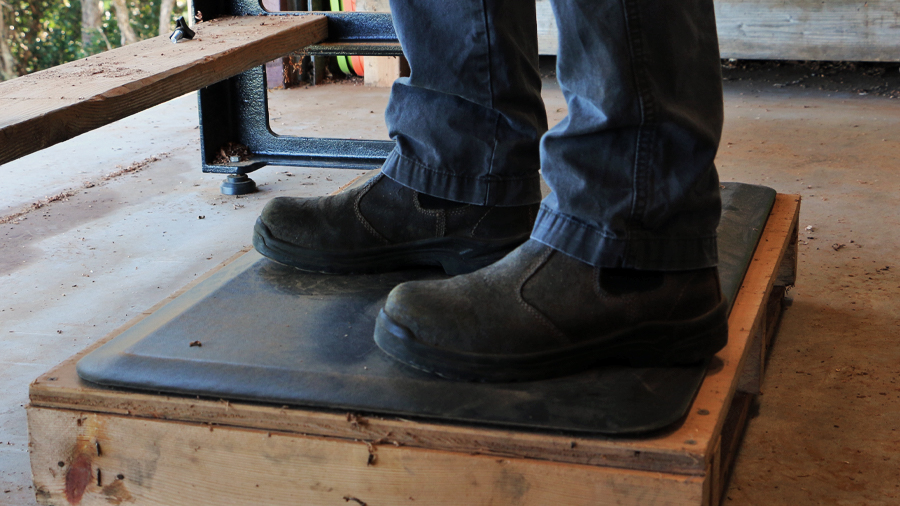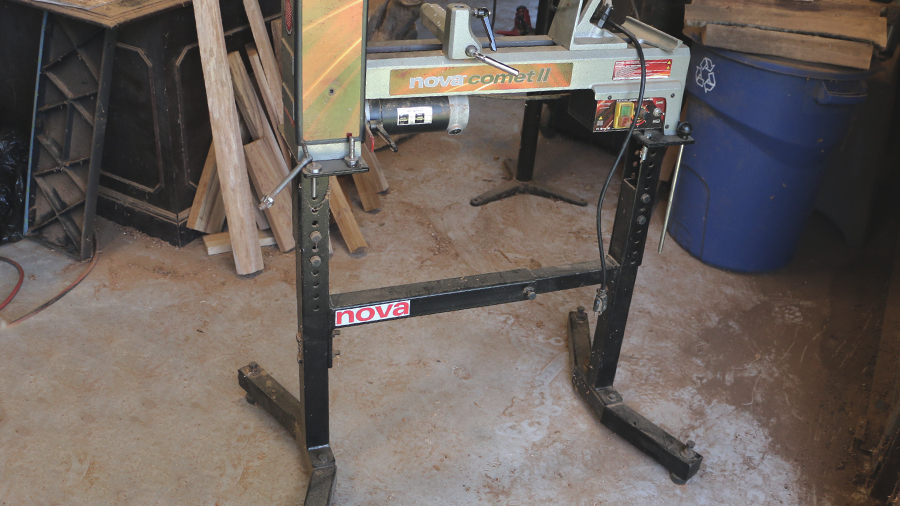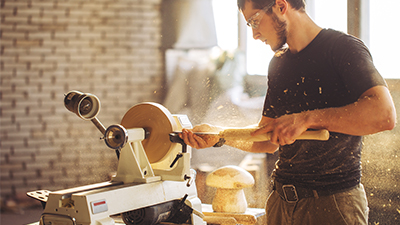Woodturning is a fascinating hobby that can turn into a profitable sideline. Getting your wood lathe properly set up is one of the challenges that face new woodturners. One of the significant factors in getting your wood lathe set up properly is the spindles’ height. How high should a wood lathe be?
The height of the lathe should be adjusted so that the spindles are at or just below your elbow height.
Your wood lathe’s proper height is where you can best control the tools and feel the most comfortable while you are turning. Finding that correct height often involves some trial and error. I have some thoughts and tips that can help you get your lathe optimized for turning your style.
Why is Wood Lathe Height That Important?
Comfort is the main reason wood lather height is so important. Woodturning often involves hours of standing at the wood lathe. If the wood lathe is too high or too low, your body will begin to let you know. Some important tips to remember about the height of your wood lathe can make turning much more enjoyable and affect the quality of your work
- Working Relaxed – Your wood lathe should be set so that the spindle is about the same height as your elbows. Fine adjustments can be made using the tool rest, but the center of the spindle at or just below your elbows allows you to work standing straight and relaxed.
- Getting the Right Angle – With the lathe at the correct height for you, and the tool rest fine-tuned for the project you are working on, you can easily maintain the proper angle on the tool you are using. The tool angle is critical to making good cuts without chatter or a dangerous throwback.
- Too low is a No Go – A lathe set to low puts the tool rest low, and you must either lean over or hold the tools with your arms too straight to easily manipulate the cutting edge of the tool. This position can also put your face over the lathe’s top, which is not a good position. You are then opened to taking wood chips and other debris under your face shield.
- Keep Your Elbows and tool handles low – If you have your wood lathe set up on your workbench, the center of the spindle may be up around your chest or shoulders. This causes you to hold the tools high, which is both tiring and dangerous. A high position forces you to hold the tools in an awkward position with the handles away from your body and your arms with your elbows up and away as well. A tool kickback puts the flying tool on a trajectory to come under your face shield.
Regardless of how you mount your wood lathe, the wood lathe’s height is a key element in the performance of the wood lathe as you are turning projects. Too often, woodturners who complain that their tools don’t work or their lathe doesn’t perform are not using their lathe most efficiently. Proper setup can make a world of difference in how your projects end.

Finding the Right Height – Make your Lathe Fit You
Many beginning woodturners bring home their lathe, set it up on an existing workbench, and then have trouble with their turning. Most workbenches are 39 inches high, which puts the spindle closer to 45 inches. Proper turning technique is nearly impossible with the tool resting this high, which is close to your shoulders.
Options for a Fit – Getting the Lathe to the Right Height
There are several options that can make fitting your wood lathe height.
- Purchase an adjustable stand
- Build a custom stand to your height requirements (See example in the picture above.)
- Modify an existing workbench

Getting Your Lathe Off the Floor – Manufactured Stands
There are almost as many options for stands and mounts for wood lathes as there are wood lathes themselves. Finding the one that works best in your situation can make woodturning an even more enjoyable experience. The pros and cons of buying an adjustable lathe stand should be considered.
Pros
- Adjustability – Most factory-made stands not only adjust in height but can be adjusted to fit varying lengths of lathes as well as provide storage options for tools and other accessories
- Availability – The manufacturer of your wood lathe probably makes a stand just to fit that lathe. Some manufacturers offer bundle deals that allow you to purchase the wood lathe and the stand at a discounted price if you purchase them at the same time.
- Versatility – You will almost always get a set of casters with a manufactured lather stand. The ability to easily roll your lathe out of the way for storage is a huge advantage.
Cons
- Cost – The biggest disadvantage of putting a manufactured stand under your wood lathe is the cost. Depending on the model and the features, the stand can sometimes cost as much as the wood lathe.
You’re a Woodworker – Build a Stand
The more economical approach in many instances is to build a stand for your wood lathe. The requirements are not difficult, and you can add any custom features you desire. Plus, you get the satisfaction of the build and using something you designed.
There are some things to consider when designing and building your wood lathe stand.
- Make it adjustable
- Make it portable
- Add storage
Spend some time considering exactly what you want in your stand. Buy good casters to make rolling easier. Include height adjustments so you can fine-tune the height of your lathe to the project you are turning, keep your tools and accessories near at hand and organized.
When Space is at a Premium – Modify your Work Bench
If space in your shop is at a premium, the thought of fitting one more floor tool into the space may seem more like a giant puzzle. If this is the case, consider modifying your existing workbench to put your wood lathe at the proper height.
Adding a drop-in space to a workbench can be an effective solution to mounting your wood lathe at the proper height and conserving space in your woodshop. A bench mounted lathe may lack some of the portability and adjustability of a stand-mounted lathe, but it provides a solid and secure location.
A lathe counted on a bench also keeps your tools and accessories close at hand, and with some ingenuity, you can organize them for the most efficient use.
A Few Words of Caution – Safety in the Shop
There is always time for a few words of caution. Wood lathes can be dangerous in several ways. You must be cognizant of the tools you are using the possible hazards. Keep these things in mind.
- Spinning parts – Wood lathes can be dangerous just when they are spinning and no wood is on the lathe. Most wood lathes are belt driven, and if the safety covers are not in place, the pulleys and belts can snag loose clothing. When wood is on the lathe, the same danger is present. Don’t let shirt tails or sleeves flap loose. Apron straps are another danger. Work safe
- Electricity is still a hazard – Maintain your lathe’s electrical parts carefully. Remember that working on a damp concrete floor or, heaven forbid, standing water can lead to an inadvertent shocking experience from a properly operating switch or plug.
- Sharp ends demand respect – Achieving good results when turning requires your chisels must be sharp. A sharp chisel being held against a rapidly rotating piece of wood has the chance of being a high-speed missile if something goes wrong. Always respect your tools and position yourself correctly to control the tool.
- Wood as shrapnel – Until you have experienced a workpiece on a lathe that explodes, you can’t really understand the sensations. For this reason, you should always wear good safety equipment when turning. This can include
- A face shield
- Safety glasses, even under the face shield
- A heavy apron that covers your chest and upper legs
- Wear a respirator – sawdust can be an irritant
Make the World and Your Wood Go Round
With a properly situated and set up wood lathe, you may fall into the trap that many woodworkers unknowingly step into. Woodturning can become such an attraction that the other tools in your shop begin to fall into disuse. Whether you are turning pens or furniture legs, the satisfaction of showering yourself in wood chips can be addictive.
We hope that this article has given you some insight and understanding of why setting your wood lathe to the correct height is important. As with many other types of woodworking, tool setup and maintenance are the key issues to performing the highest quality work. Keep the woodturning and the chips flying!

